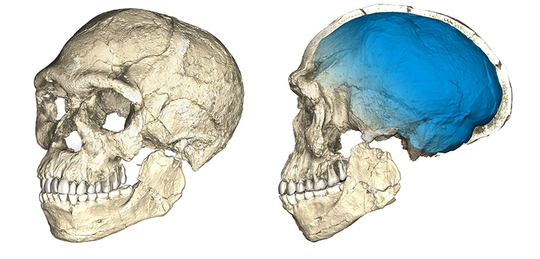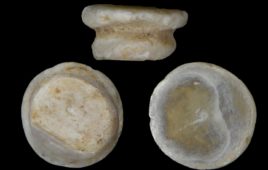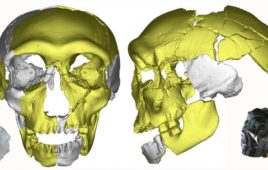
The first of our kind. Two views of a composite reconstruction of the earliest known Homo sapiens fossils from Jebel Irhoud (Morocco) based on micro computed tomographic scans of multiple original fossils. Dated to 300 thousand years ago these early Homo sapiens already have a modern-looking face that falls within the variation of humans living today. However, the archaic-looking virtual imprint of the braincase (blue) indicates that brain shape, and possibly brain function, evolved within the Homo sapiens lineage. Credit: Philipp Gunz, MPI EVA Leipzig (License: CC-BY-SA 2.0)
The discovery of uncovered fossil bones has pushed the date of the first ancient Homo sapiens back another 100,000 years.
An international research team— led by Jean-Jacques Hublin of the Max Planck Institute for Evolutionary Anthropology in Germany and Abdelouahed Ben-Ncer of the National Institute for Archeology and Heritage in Morocco— have discovered skulls, teeth and long bones of at least five individuals, as well as stone tools and animal bones in Morocco dating back to about 300,000 years ago.
The previous oldest Homo sapien fossils, found on the site of Omo Kibish in Ethiopia, dated back 195,000 years ago.
Another discovery in Ethiopia showed fossils dating back 160,000 years ago, leading researchers to believe that human life descended from East Africa around 200,000 years ago.
“We used to think that there was a cradle of mankind 200 thousand years ago in east Africa but our new data reveal that Homo sapiens spread across the entire African continent around 300 thousand years ago,” Hublin said in a statement. “Long before the out-of-Africa dispersal of Homo sapiens, there was dispersal within Africa.”
The fossils where found at Jebel Irhoud, an archaeological cave located in the north African country of Morocco, that is known for being plentiful with human fossils and Middle Stone Age artifacts.
The researchers used the thermoluminescence dating method on heated flints found in the deposits to confirm the age of the fossils.
“Well dated sites of this age are exceptionally rare in Africa but we were fortunate that so many of the Jebel Irhoud flint artefacts had been heated in the past,” geochronology expert Daniel Richter of the Max Planck Institute and now with Freiberg Instruments GmbH, said in a statement. “This allowed us to apply thermoluminescence dating methods on the flint artefacts and establish a consistent chronology for the new hominin fossils and the layers above them.”
Modern human crania are characterized by a combination of features that distinguish from ancient relatives and ancestors, including a small and gracile face and a globular braincase.
The fossils discovered show a modern-looking face and teeth and a large but more archaic-looking braincase. The researchers used microcomputer tomographic scans and statistical shape analysis based on hundreds of 3D measurements to show that the facial shape of the fossils are almost indistinguishable from modern humans.
However, the crania retain an elongated archaic shape of the braincase in contrast to their modern facial morphology.
“The inner shape of the braincase reflects the shape of the brain,” paleoanthropologist Philipp Gunz from Max Planck, said in a statement. “Our findings suggest that modern human facial morphology was established early on in the history of our species, and that brain shape, and possibly brain function, evolved within the Homo sapiens lineage.”
Along with the new discovery, the researchers used recalculated the age of three mandible fossils found at the site in the 1960s that were previously thought to be from 160,000 years ago and now are considered much older.
“We employed state of the art dating methods and adopted the most conservative approaches to accurately determine the age of Irhoud,” Richter said.




